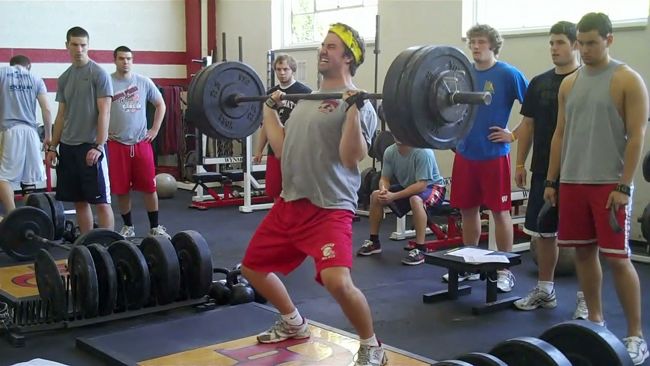
You might disagree, but hear me out on this. As an ex-college football player and currently a strength coach, I’ve found the utilization and teaching of Olympic lifts to be tedious, inefficient, and downright boring. As a college athlete, I hardly found the patience to learn the correct lifting technique for the power clean. Although I held the St. John’s University power clean record in my freshman season, muscling 335 lbs (152 kg) off the platform, my technique was completely flawed. My attempt looked more like an axle clean and press in Strongman than the smooth pull of an Olympic weightlifter.
After my undergraduate years, I studied exercise science at the graduate level. The director of the master’s program was an avid Olympic weightlifting coach and ex-competitor. He spent hours with his students teaching us the finer points and intricacies of how to perform a proper clean and jerk. Once we were proficient enough at performing these lifts, we were granted permission to coach the university’s athletes on how to use these lifts to better their sports performance.
I remember the very first day that I was given the “ok” to start coaching athletes. I was assigned to the football team. Because I had been a former college football player myself, I felt that I would instantly be greeted with fellowship and amity. This was not the case! In fact, there were a few kids who hated the fact that I was there. I sensed their apprehension in allowing me to coach them, and they especially hated it when I taught them how to Olympic lift.
As it happened, many of the more “meathead-ish” type football players confided in me that they wanted to “lift heavier weights and stop wasting time with this BS.” As it turned out, these athletes were first exposed to the technicalities of Olympic lifting during the off-season prior to my debut. It was also the first time that they had been coached in the weight room by graduate students instead of their sports coach. They had previously been using a powerlifting model that yielded great size and strength gains.
I believe that including power cleans and other Olympic lifts into a strength and conditioning program for football players is beneficial. However, I also believe that the less an athlete has to “think” about a movement, the more attitude he can bring to its accomplishment. Also, I’m a big advocate for saving time. There’s nothing I hate more than “getting things right before you get them going.” It’s a personal philosophy of mine that “success is more a product of attitude… than of technique.” (Of course, don’t take foolish risks that may cause injury.)
Consider this for a moment. When you’re coaching a player on the kick-off team, do you tell him, “Johnny, sprint down there with your elbows at a 90-degree angle with your jaw relaxed and your hands in loose fists. Be sure to breathe through pursed lips. When you get to the first blocker, take a short inhalation and hold your breath. Brace your abdominals, furrow your brow, and dip your hips. Lower your shoulders and explode through by extending your ankles, knees, and hips in a simultaneous manner.”
If this sounds crazy to you, consider that this is the way Olympic lifts are typically taught. Instead of letting the athlete “do his thing,” we spend hours “breaking down” and analyzing the movement for them. These valuable hours spent “teaching” the movement could very well be used for building real strength and speed in a timely fashion.
In the same manner that you coach your athletes to go “balls to the wall” on the football field, you can coach them to go “balls to the wall” in the weight room. Besides getting bigger, faster, and stronger by training like a maniac, these kids will bring this type of attitude to the field more often. Like the saying goes, “you play the way that you practice.”
Training in the weight room should be just as intense and as fun as training on the field. When athletes learn to “attack” an exercise in the gym like they attack a tackling dummy, they will develop size, strength, speed, and attitude faster than ever before. For weight training to become a real part of your school’s program, you’ve got to promote it as a benefit of being on the team, not just a necessity. I remember looking at a few small colleges when I graduated high school. One of the most important questions I asked was, “What kind of strength and conditioning program do you have?”
So, what the heck do you do if Olympic lifts aren’t working? Train like the world’s strongest men! Not only are Strongmen great examples of brute strength, they are also well-conditioned and possess great speed and power. Strongman exercises build functional strength, speed, power, and most importantly, attitude! Besides the performance benefits of flipping tires and loading sandbags, Strongman training is fun and easy to teach.
In part two, I’ll give you my list of the best Strongman exercises for building explosive strength, speed, size, and attitude.








